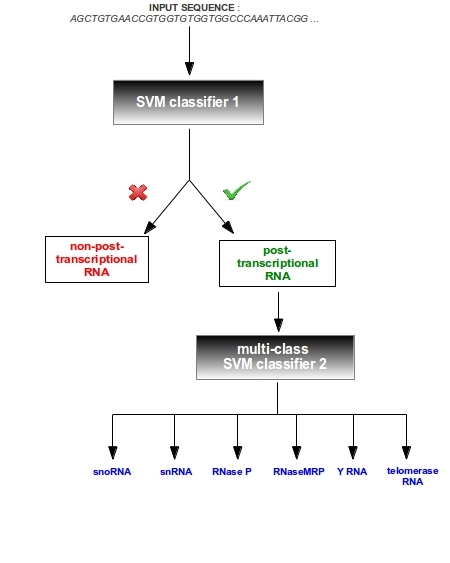Prediction of non-coding RNAs that are involved in post-transcriptional modification or DNA replication
The server aims for the prediction and classification of post-transcriptional RNA (ptRNA), which is a group of ncRNA that is involved in post-transcriptional modification or DNA replication. It can (i) predict, whether it will be ptRNA or non-ptRNA and (ii) predict the RNA class. Currently it can predict the 6 ptRNA families that exist in eukaryotes: snRNA, snoRNA, RNase P, RNase MRP, Y RNA and telomerase RNA. The tool uses an SVM based algorithm with sequence, secondary structure and thermo dynamical properties as input vectors. The prediction is as two-step approach. In the first step, a binary classifier distinguishes ptRNA from non-ptRNA. The next step contains multiclass classification, in which the tool identifies the ptRNA family that the sequence belongs to.

snRNA: localized in the nucleus, where they are found in combination with proteins (snRNP). As part of the spliceosome they are catalytically active and involved in the recognition and splicing of the pre-mRNA in the nucleus.
snoRNA: subclass of snRNA, that is localized in the nucleolus and in the cajal bodies of eukaryotes. It is involved in the chemical modification of tRNA, rRNA and snRNA as well as the synthesis of RNA.
RNase P: ribozyme that cleaves off a precursor sequence of tRNA molecules. Additionally, RNase P is one of the two known multiple turnover ribozymes in nature. Furthermore, RNase P is required for the normal and efficient transcription of various small noncoding RNA genes.
RNase MRP: enzymatically active ribonucleoprotein, which on the one hand plays a role in the initiation of the replication of mitochondrial DNA and on the other hand is involved in the processing of precursor rRNA.
Y RNA: small non-coding RNA component of the Ro ribonucleoprotein particle. On the one hand, it functions as a repressor of Ro. On the other hand it is functionally required for DNA replication.
Telomerase RNA: component of the telomerase, works against the shortening of the ends of eukaryotic chromosomes (telomeres) during cell division.

snRNA: localized in the nucleus, where they are found in combination with proteins (snRNP). As part of the spliceosome they are catalytically active and involved in the recognition and splicing of the pre-mRNA in the nucleus.
snoRNA: subclass of snRNA, that is localized in the nucleolus and in the cajal bodies of eukaryotes. It is involved in the chemical modification of tRNA, rRNA and snRNA as well as the synthesis of RNA.
RNase P: ribozyme that cleaves off a precursor sequence of tRNA molecules. Additionally, RNase P is one of the two known multiple turnover ribozymes in nature. Furthermore, RNase P is required for the normal and efficient transcription of various small noncoding RNA genes.
RNase MRP: enzymatically active ribonucleoprotein, which on the one hand plays a role in the initiation of the replication of mitochondrial DNA and on the other hand is involved in the processing of precursor rRNA.
Y RNA: small non-coding RNA component of the Ro ribonucleoprotein particle. On the one hand, it functions as a repressor of Ro. On the other hand it is functionally required for DNA replication.
Telomerase RNA: component of the telomerase, works against the shortening of the ends of eukaryotic chromosomes (telomeres) during cell division.